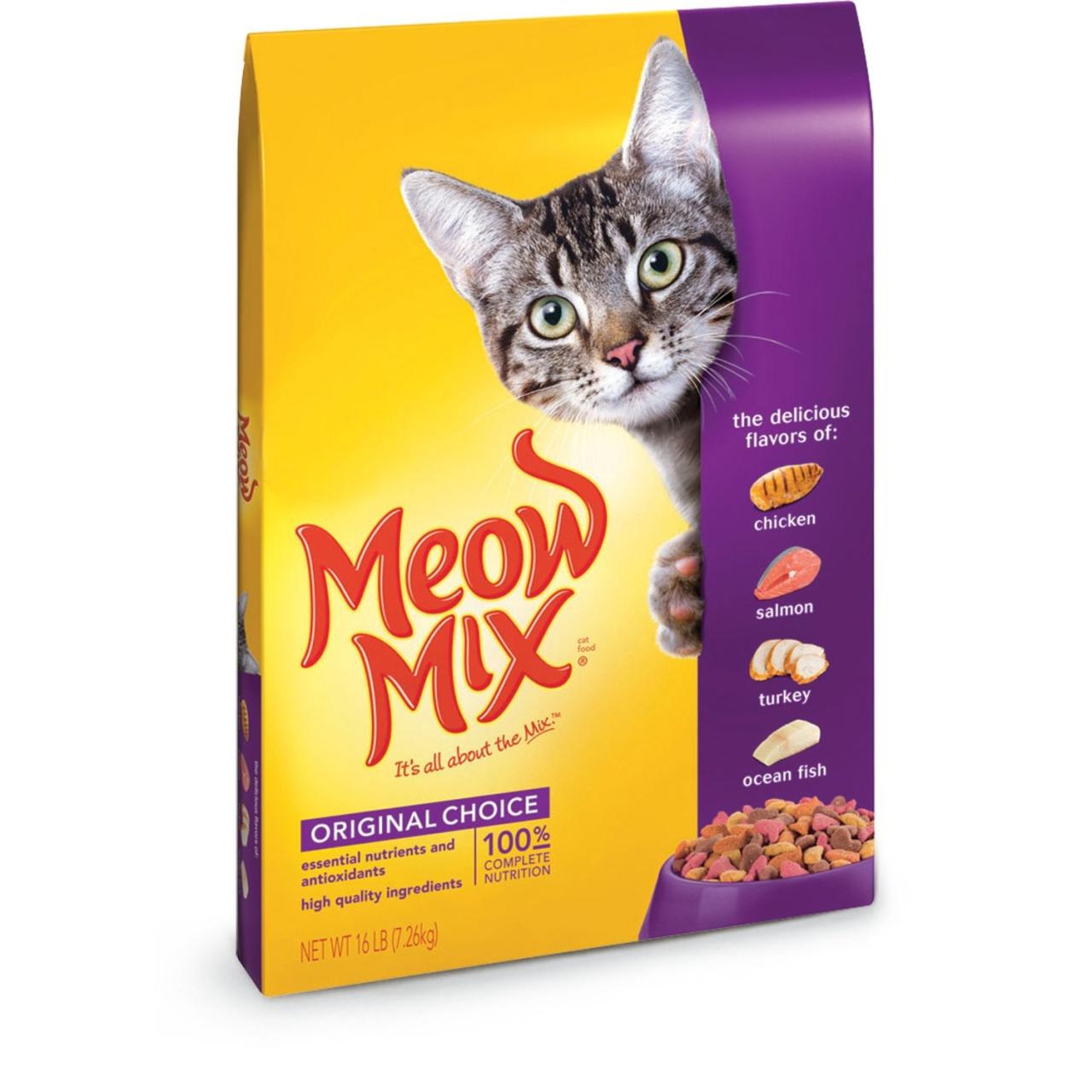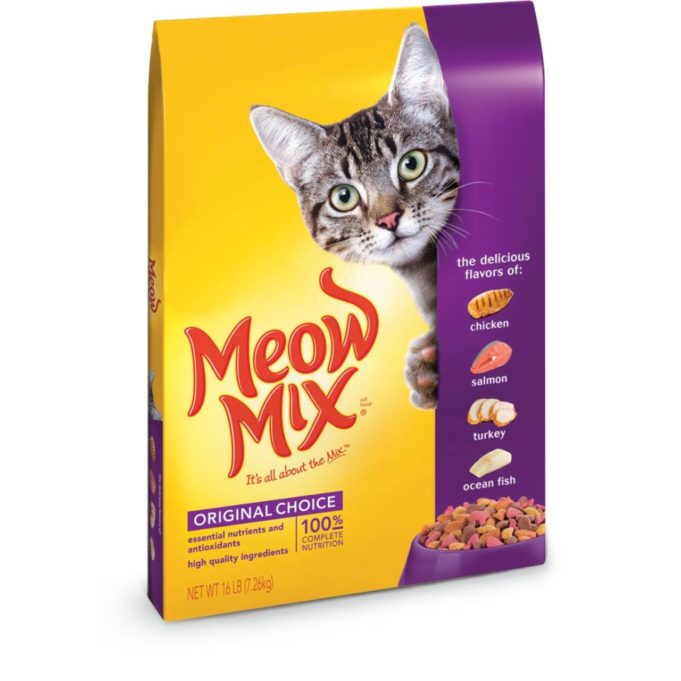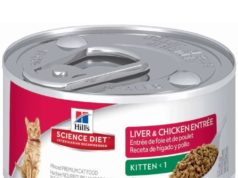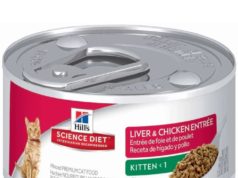Best food brands for cats are a topic that ignites passionate debates among feline enthusiasts. Every cat owner wants to ensure their furry friend enjoys a diet packed with the nutrients they need to thrive, but navigating the vast world of cat food can feel like deciphering ancient hieroglyphics.
This guide aims to shed light on the best food brands for cats, helping you make informed choices that support your cat’s health and happiness.
We’ll delve into the essential nutritional needs of cats, exploring how those needs vary depending on their age, breed, and activity levels. We’ll then introduce you to a selection of top-rated cat food brands, categorizing them based on their target audience and key features.
We’ll also provide valuable insights on deciphering ingredient lists, understanding feeding guidelines, and addressing special dietary considerations. By the end of this journey, you’ll be equipped to select the purrfect food for your feline companion.
Understanding Cat Nutritional Needs
Your feline friend’s health depends on a balanced diet that meets their specific nutritional needs. Just like humans, cats require a variety of essential nutrients for optimal growth, development, and overall well-being.
Essential Nutrients for Cats
Cats have unique dietary requirements compared to other animals. They are obligate carnivores, meaning they must obtain certain nutrients from animal-based sources. These essential nutrients include:
- Protein:Cats require a high protein intake to support muscle growth, tissue repair, and enzyme production. Animal-based protein sources like meat, poultry, and fish are easily digestible and provide the necessary amino acids.
- Fat:Fats are crucial for energy production, hormone synthesis, and absorption of fat-soluble vitamins. Healthy fats like omega-3 and omega-6 fatty acids promote skin and coat health.
- Taurine:This amino acid is essential for heart, eye, and reproductive health. Cats cannot produce taurine on their own and must obtain it from their diet.
- Arginine:This amino acid is vital for the immune system, wound healing, and nitrogen removal.
- Vitamin A:Essential for vision, growth, and immune function.
- Vitamin D:Plays a crucial role in calcium absorption and bone health.
- Vitamin E:An antioxidant that protects cells from damage.
- Vitamin K:Essential for blood clotting.
- Thiamine (Vitamin B1):Important for nerve function and energy production.
- Niacin (Vitamin B3):Essential for energy production and DNA repair.
- Pantothenic Acid (Vitamin B5):Plays a role in energy production and hormone synthesis.
- Pyridoxine (Vitamin B6):Essential for protein metabolism and brain function.
- Biotin (Vitamin B7):Important for skin and coat health.
- Folate (Vitamin B9):Essential for cell growth and DNA synthesis.
- Cobalamin (Vitamin B12):Crucial for red blood cell production and nerve function.
- Calcium:Essential for bone growth, muscle function, and nerve transmission.
- Phosphorus:Important for bone health, energy production, and cell function.
- Magnesium:Plays a role in muscle function, nerve transmission, and energy production.
- Potassium:Essential for fluid balance and nerve function.
- Sodium:Important for fluid balance and nerve function.
- Chloride:Essential for fluid balance and acid-base balance.
Nutritional Needs by Life Stage
Dietary requirements change throughout a cat’s life.
Kittens
Kittens are growing rapidly and require a diet higher in calories, protein, and fat to support their development.
- High-calorie diet:Kittens need more calories than adult cats to fuel their growth.
- Increased protein:Protein is essential for muscle growth and tissue development.
- Essential fatty acids:Kittens need adequate amounts of omega-3 and omega-6 fatty acids for brain development and healthy vision.
- Taurine:Taurine is crucial for heart and eye development.
- Calcium and phosphorus:These minerals are essential for bone growth and development.
Adult Cats
Adult cats have different nutritional needs compared to kittens. They require a balanced diet that maintains their weight, supports their energy levels, and provides essential nutrients for overall health.
- Moderate calorie intake:Adult cats need a moderate amount of calories to maintain their weight.
- Adequate protein:Protein is still important for maintaining muscle mass and tissue repair.
- Essential fatty acids:Omega-3 and omega-6 fatty acids continue to be important for skin and coat health.
- Taurine:Taurine remains essential for heart and eye health.
Senior Cats
Senior cats often experience changes in metabolism and activity levels, requiring adjustments to their diet.
- Reduced calorie intake:Senior cats may require fewer calories to maintain a healthy weight due to decreased activity levels.
- High-quality protein:Protein is crucial for maintaining muscle mass and supporting a healthy immune system.
- Joint support:Senior cats may benefit from supplements or foods that support joint health.
- Kidney support:Some senior cats may require a diet that reduces the strain on their kidneys.
Top Cat Food Brands: Best Food Brands For Cats
Choosing the right cat food can be a daunting task, with countless brands and formulas vying for your attention. But fear not, feline friends! We’re here to help you navigate the world of cat food and find the perfect purrfect meal for your furry companion.
Reputable Cat Food Brands
This section explores some of the most popular and trusted cat food brands available, offering a diverse range of options for various feline needs.
| Brand Name | Product Type | Price Range | Key Features |
|---|---|---|---|
| Purina Pro Plan | Dry, Wet, Raw | $$ | Formulated with high-quality ingredients, including real meat, and caters to different life stages and dietary needs. |
| Royal Canin | Dry, Wet | $$$ | Known for its breed-specific formulas and tailored nutrition for various health concerns. |
| Hill’s Science Diet | Dry, Wet | $$$ | Focuses on clinically proven nutrition for various health conditions and life stages. |
| Blue Buffalo | Dry, Wet | $$ | Emphasizes natural ingredients and avoids artificial flavors, colors, and preservatives. |
| Wellness Complete Health | Dry, Wet | $$$ | Offers a wide range of formulas with natural ingredients and a focus on holistic health. |
Ingredient Analysis
Decoding the label is like deciphering a secret code – it’s the key to unlocking the nutritional goodness (or lack thereof) within your cat’s food. Understanding the ingredients is essential for making informed decisions about your feline friend’s diet.
Key Ingredients and Their Impact
The ingredients list is your roadmap to understanding what’s in your cat’s food. It’s listed in descending order of weight, meaning the ingredient that makes up the largest portion of the food is listed first.
Protein
Protein is the building block of life for cats, and it’s essential for muscle growth, tissue repair, and a healthy immune system.
Cats are obligate carnivores, meaning they require animal-based protein for optimal health.
Look for high-quality protein sources like meat, poultry, or fish listed at the top of the ingredient list. Avoid foods with fillers like corn, wheat, or soy, which are not easily digestible by cats and can lead to digestive issues.
Carbohydrates
While cats don’t need a lot of carbohydrates, they do play a role in providing energy.
Carbohydrates should make up a small percentage of a cat’s diet, ideally less than 10%.
Look for complex carbohydrates like brown rice or sweet potatoes, which are easier for cats to digest than simple carbohydrates like corn or wheat.
Fats
Fats are essential for energy, insulation, and hormone production. Look for healthy fats like omega-3 and omega-6 fatty acids, which can be found in fish oil, flaxseed oil, and certain types of meat.
Avoid foods with excessive amounts of saturated or trans fats, as these can contribute to obesity and other health problems.
Vitamins and Minerals
Vitamins and minerals are crucial for a wide range of bodily functions, from vision and bone health to immune system function and energy production. Look for foods that include a balanced spectrum of vitamins and minerals, including vitamin A, vitamin D, vitamin E, vitamin K, taurine, and iron.
Common Ingredients and Their Impact
Here’s a breakdown of common ingredients found in cat food and their potential benefits or drawbacks:
Meat By-Products
Meat by-products are often used as a source of protein in cat food. They can include organs, bones, and other parts of the animal. While not inherently bad, it’s important to look for foods that specify the type of meat by-product used, as some can be less digestible than others.
Animal Fat
Animal fat is a common source of energy and essential fatty acids in cat food. It can come from a variety of sources, including chicken fat, beef fat, and pork fat. Look for foods that use healthy fats like chicken fat or fish oil.
Finding the best food brands for your feline friend can be a real cat-astrophe! You want something nutritious, delicious, and that won’t turn your furry companion into a fluffy, couch-potato. But hey, if you’re looking to shed a few pounds yourself, maybe check out this link for the best diet to lose weight – you might be surprised how much you have in common with your cat! Back to the cat food, though, remember to choose a brand with high-quality ingredients and a balanced diet.
Your kitty will thank you for it, and you’ll have a purrfectly healthy companion.
Grains
Grains are often used as fillers in cat food. While some grains like brown rice or oatmeal can be digestible for cats, others like corn or wheat can cause digestive issues.
Vegetables
Vegetables can provide fiber and other nutrients to cats. Look for foods that use a variety of vegetables, including peas, carrots, and spinach.
Preservatives
Preservatives are used to extend the shelf life of cat food. Some common preservatives include BHA, BHT, and ethoxyquin. While these preservatives are generally considered safe, some pet owners prefer to avoid them.
Choose foods with natural preservatives like vitamin E or rosemary extract.
Feeding Guidelines
Determining the right amount of food for your feline friend is a crucial step in ensuring their health and well-being. Just like humans, cats have varying needs based on their age, activity level, and weight. Let’s dive into the details to find the perfect feeding plan for your furry companion.
Choosing the best food brands for cats can be a real cat-astrophe! You want to make sure they’re getting the right nutrients, but it’s easy to get lost in the jungle of protein percentages and fat ratios. If you’re feeling overwhelmed, maybe take a moment to brush up on what are diet macros – it’s like deciphering the ancient Egyptian hieroglyphics of your cat’s food label! Once you’ve got a handle on those macros, you’ll be a purrfectly informed cat parent, ready to choose the best brand for your furry friend.
Determining the Right Food Amount
The recommended daily food intake for cats is influenced by a combination of factors, including:
- Age:Kittens require more calories for growth and development, while senior cats need fewer calories due to slower metabolisms.
- Weight:Maintaining a healthy weight is essential for cats. Overfeeding can lead to obesity, while underfeeding can cause malnutrition.
- Activity Level:Active cats, like those who spend a lot of time playing or exploring, require more calories than sedentary cats.
A good starting point is to follow the feeding guidelines provided on the cat food packaging. However, it’s important to note that these are just general recommendations. Consult with your veterinarian to determine the precise amount of food your cat needs based on their individual needs.
They can also assess your cat’s weight and body condition score to ensure they are receiving the right amount of food.
Feeding Frequency and Meal Times, Best food brands for cats
The frequency of feeding depends on your cat’s age and lifestyle. Here’s a general guide:
- Kittens:Kittens need to eat frequently to support their rapid growth. They should be fed 4-6 times a day until they are around 6 months old.
- Adult Cats:Adult cats typically need 2 meals a day. However, some cats may benefit from more frequent meals, especially if they are prone to digestive issues.
- Senior Cats:Senior cats may prefer smaller, more frequent meals throughout the day. This can help prevent digestive upset and promote better nutrient absorption.
It’s important to establish a consistent feeding schedule. This helps regulate your cat’s digestive system and prevent overeating. Avoid leaving food out all day, as this can lead to overeating and weight gain. Instead, provide fresh food at designated meal times.
Transitioning to a New Food Brand
Introducing a new food brand gradually is essential to avoid digestive upset. Abrupt changes in diet can lead to diarrhea, vomiting, and other digestive issues. Here’s a step-by-step guide for transitioning your cat to a new food brand:
- Start slowly:Begin by mixing a small amount of the new food with your cat’s current food. Start with a 25% ratio of new food to old food, gradually increasing the proportion of new food over the next 7-10 days.
- Monitor your cat’s reaction:Pay close attention to your cat’s behavior and stool consistency during the transition. If you notice any signs of digestive upset, slow down the transition process.
- Be patient:It may take a few weeks for your cat to fully adjust to the new food. If you have any concerns, consult with your veterinarian.
Remember, every cat is unique. What works for one cat may not work for another. Always consult with your veterinarian for personalized feeding recommendations.
Special Dietary Considerations
Just like humans, cats can have specific dietary needs based on their health conditions. Whether it’s allergies, kidney problems, or weight management, finding the right food can make a world of difference in their well-being. Let’s explore some common dietary considerations for our feline friends.
Food Allergies in Cats
Food allergies are a common concern for cat owners. Cats can develop allergies to various ingredients, including protein sources like chicken, beef, fish, or dairy products. Symptoms can range from mild skin irritation to severe gastrointestinal issues.
- Signs of Food Allergies:Skin problems (itching, hair loss, redness), digestive upset (vomiting, diarrhea, gas), and even respiratory issues.
- Diagnosis and Treatment:A veterinarian can help diagnose food allergies through elimination diets and allergy testing. Treatment involves identifying and avoiding the offending ingredient.
- Specialized Food Brands:Several brands offer hypoallergenic cat food formulas designed to address common food allergies. These formulas typically use novel protein sources like venison, duck, or rabbit, which are less likely to trigger allergic reactions.
Kidney Disease in Cats
Kidney disease is a serious health condition that affects the ability of the kidneys to filter waste products from the blood. As kidney function declines, cats may experience a loss of appetite, weight loss, increased thirst, and frequent urination.
- Dietary Considerations:Cats with kidney disease require a diet low in protein, phosphorus, and sodium, and high in essential fatty acids and antioxidants. These nutrients help support kidney function and reduce the buildup of toxins in the blood.
- Specialized Food Brands:Many brands offer veterinary-formulated kidney diets that are specifically designed to meet the nutritional needs of cats with kidney disease. These diets are often available in both wet and dry forms.
Obesity in Cats
Obesity is a growing concern for cats, and it can lead to a variety of health problems, including diabetes, arthritis, and heart disease.
- Weight Management:To help your cat lose weight, you’ll need to reduce their calorie intake and increase their physical activity. This may involve switching to a lower-calorie diet, reducing the amount of food you give them, and providing more opportunities for play and exercise.
- Specialized Food Brands:Several brands offer weight management cat food formulas that are lower in calories and fat, and higher in fiber. These formulas help cats feel full while reducing their overall calorie intake.
Importance of Veterinary Consultation
It’s crucial to consult with your veterinarian before making any changes to your cat’s diet, especially if they have a health condition. A veterinarian can assess your cat’s individual needs and recommend the best diet for their specific situation.
“Veterinarians can provide personalized dietary advice tailored to your cat’s age, breed, activity level, and health conditions.”
Food Safety and Storage
Keeping your cat’s food fresh and safe is crucial for their health. Just like humans, cats can get sick from eating spoiled or contaminated food. This section will provide you with guidelines on how to properly store your cat’s food and prevent food-related illnesses.
Storing Cat Food Properly
Storing cat food correctly is essential to prevent spoilage and ensure its freshness. This will help maintain the nutritional value and palatability of the food, keeping your cat healthy and happy.
- Dry Food:Store dry cat food in an airtight container in a cool, dry place. Avoid storing it in direct sunlight or in areas with high humidity.
- Wet Food:Wet food is more susceptible to spoilage than dry food. It should be stored in the refrigerator after opening and used within 1-2 days. You can also freeze wet food for up to 2-3 months, but it’s important to thaw it completely in the refrigerator before serving.
Risks of Feeding Cats Expired or Contaminated Food
Feeding your cat expired or contaminated food can have serious consequences for their health. These risks include:
- Food Poisoning:Bacteria and other pathogens can grow in spoiled food, leading to food poisoning. Symptoms of food poisoning in cats can include vomiting, diarrhea, lethargy, and loss of appetite.
- Nutritional Deficiencies:Expired food may lose its nutritional value, leading to deficiencies that can impact your cat’s overall health.
- Gastrointestinal Issues:Spoiled food can irritate the digestive system, leading to vomiting, diarrhea, and other gastrointestinal problems.
Preventing Food-Related Illnesses in Cats
By following these tips, you can help prevent food-related illnesses in your cat:
- Wash Your Hands:Wash your hands thoroughly with soap and water before handling your cat’s food.
- Clean Food Bowls:Wash your cat’s food bowls daily with hot, soapy water to remove any bacteria or food residue.
- Inspect Food Before Serving:Check your cat’s food for signs of spoilage, such as mold, discoloration, or an off smell.
- Avoid Leaving Food Out:Remove any uneaten food from your cat’s bowl within 30 minutes to prevent spoilage.
- Store Food Properly:Always store your cat’s food according to the manufacturer’s instructions.
Choosing the Right Food

Selecting the perfect food for your feline companion is like finding the perfect purrfect match! It’s not just about picking a brand that sounds good, it’s about understanding your cat’s unique needs and finding a food that meets them.
Evaluating Food Quality
To ensure your cat is getting the best nutrition, it’s crucial to evaluate the quality of the food you choose. Look for brands that use high-quality ingredients and avoid artificial additives, fillers, and by-products. A good rule of thumb is to check the ingredient list: the first few ingredients should be real meat, poultry, or fish.
Finding the best food brands for cats can be a real cat-astrophe! You’ve got to navigate the maze of ingredients, protein percentages, and those fancy “holistic” labels. But don’t worry, there’s a way to make sense of it all – just use the right Keywords when searching online! Once you’ve got those keywords down, you’ll be a pro at finding the purrfect food for your feline friend.
- Protein Source:The first few ingredients should be real meat, poultry, or fish. Look for specific names, like “chicken,” “salmon,” or “turkey,” rather than vague terms like “meat by-products.”
- Carbohydrates:Cats are obligate carnivores, meaning they need a high-protein diet. Look for foods with moderate levels of carbohydrates, ideally from sources like brown rice, oats, or sweet potatoes.
- Fat:Cats need healthy fats for energy and skin and coat health. Look for foods with fats from sources like chicken fat, fish oil, or flaxseed.
- Vitamins and Minerals:Ensure the food contains a balanced profile of essential vitamins and minerals, like taurine, vitamin E, and zinc.
- Additives:Avoid foods with artificial colors, flavors, and preservatives. Opt for natural alternatives whenever possible.
Choosing a Brand
Once you’ve considered the quality of the food, it’s time to choose a brand that aligns with your cat’s specific needs and preferences. Consider factors like your cat’s age, breed, activity level, and any health conditions.
- Age:Kittens have different nutritional needs than adult cats, and senior cats require a diet formulated for their aging bodies.
- Breed:Certain breeds, like Maine Coons or Persians, have unique dietary requirements.
- Activity Level:Active cats need more calories and protein than sedentary cats.
- Health Conditions:If your cat has allergies, urinary tract issues, or other health conditions, choose a food specifically designed to address these needs.
Budget and Availability
Finally, consider your budget and the availability of the food. While high-quality food can be more expensive, it’s an investment in your cat’s health and well-being.
- Budget:Set a realistic budget for your cat’s food and look for brands that offer a good balance of quality and price.
- Availability:Ensure the food you choose is readily available in your area, either at local pet stores or online retailers.
Final Conclusion
Choosing the best food brands for cats is a crucial step in providing them with a long and healthy life. By understanding their nutritional needs, exploring reputable brands, and considering their individual preferences, you can create a personalized diet that fuels their playful energy, keeps their coats shiny, and ensures they live their best nine lives.
Remember, consulting your veterinarian is always a wise decision, especially if your cat has specific health concerns or dietary requirements. So, grab your cat’s favorite toy, settle in, and let’s embark on this exciting journey together!
Q&A
What are the signs of a cat food allergy?
Common signs include skin irritation, digestive upset (vomiting, diarrhea), and hair loss. If you suspect your cat has a food allergy, consult your veterinarian for proper diagnosis and treatment.
Can I switch my cat’s food abruptly?
It’s best to transition your cat to a new food gradually over a week to avoid digestive upset. Start by mixing a small amount of the new food with their current food, increasing the proportion of the new food daily.
How often should I feed my cat?
The frequency of feeding depends on your cat’s age, activity level, and food type. Kittens typically need to eat more frequently than adult cats. Consult your veterinarian for personalized feeding recommendations.
Is it safe to give my cat human food?
While some human foods are safe for cats in moderation, others can be toxic. Avoid giving your cat foods like chocolate, onions, garlic, grapes, and raisins. Consult your veterinarian for a list of safe human foods for cats.
























